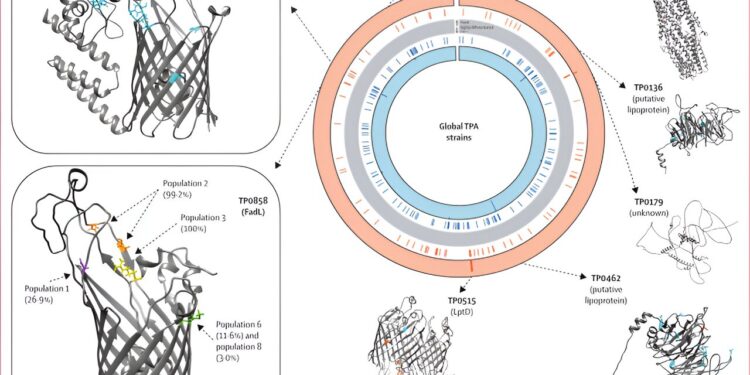Accumulation of lineage- and population-associated missense mutations in some TPA proteins. Credit: The Lancet Microbe (2024). DOI: 10.1016/S2666-5247(24)00087-9
Syphilis cases have been rising worldwide, forcing public health officials to look for ways to stop the spread. Now, a large collaborative study of syphilis genetics across four continents has found clues to a potential vaccine target.
The book is published in The Lancet Microbe newspaper.
Syphilis is a sexually transmitted disease that first appeared in Europe about 500 years ago. Its early symptoms can vary, but the spiral-shaped bacteria that cause it can persist in the body for years, often in the central nervous system, and cause birth defects when it infects infants in utero. Cases of syphilis declined in the mid-20th century due to simple and effective treatment with injectable penicillin, and became rare in the 1990s due to changes in sexual behavior following the HIV epidemic.
But recently, syphilis has made a comeback. According to the Centers for Disease Control and Prevention (CDC), there were 207,255 cases in the United States in 2022, more than at any time since the 1950s. Babies, some of them stillborn, accounted for 3,755 of those cases. Other countries around the world are seeing the same alarming upward trend.
Stopping the spread of syphilis has become an urgent public health goal. Now, an international collaboration of researchers and physicians has conducted one of the most comprehensive genomic studies of the syphilis bacteria to date and correlated the genetic data with clinical information from the patients who provided the samples. They are using this data to look for proteins on the surface of the microbe that do not vary. Such stable proteins could be good targets for a vaccine.
Several previous scientific studies using whole genome sequencing of Treponema pallidum subsp. pallidum (the bacterium that causes syphilis, abbreviated as TPA) have helped researchers begin to understand the global distribution of circulating strains. However, few sample analyses to assess the clinical and genetic diversity of TPA to inform syphilis vaccine development have been conducted.
This study recruited participants from four countries, including Colombia, China, Malawi, and the United States. TPA genome samples from Africa and South America had been underrepresented in previous genetic studies and were a particularly valuable addition to the TPA genetic dataset.
Once the samples were collected, they were sent to the Institute for Global Health and Infectious Diseases at the University of North Carolina at Chapel Hill (UNC-Chapel Hill) to have their genetic sequences mapped in the lab of Dr. Jonathan Parr.
“Whole genome sequencing samples collected by partners around the world have improved our understanding of circulating Treponema pallidum strains. The results help us understand differences between strains and identify targets for vaccine development,” Parr said.
The researchers’ genetic mapping and protein modeling revealed that syphilis bacteria differed significantly across continents, but there were enough similarities that the researchers believed they could find good targets for an effective global vaccine.
Justin Radolf, a professor at UConn School of Medicine and one of the lead authors of the paper, stressed the significance of the findings.
“By mapping mutations onto three-dimensional models of the bacteria’s proteins, we have gained crucial information that will inform the design of a syphilis vaccine,” Radolf said.
UNC-Chapel Hill researchers are assessing vaccine acceptability to determine what concerns individuals may have about participating in future syphilis vaccine trials and the potential impact of a vaccine on key populations.
“It’s really important to engage with the community now to get patients’ opinions and concerns about a future syphilis vaccine trial before the vaccine is even developed,” said Dr. Arlene C. Seña of UNC-Chapel Hill, co-leader of the clinical study that enrolled participants from around the world and lead author of the study.
The team has already secured funding to continue its efforts to develop a syphilis vaccine.
“This study highlights the power of collaboration,” said Juan Salazar, chief medical officer at Connecticut Children’s Hospital and co-director of the project, who is also chair of the department of pediatrics at UConn School of Medicine. “Our work here is not just about addressing a local health problem; it’s about contributing to a global solution to a disease that continues to affect millions of people around the world.”
More information:
Arlene C Seña et al., Clinical and genomic diversity of Treponema pallidum subspecies pallidum to inform vaccine research: an international molecular epidemiology study, The Lancet Microbe (2024). DOI: 10.1016/S2666-5247(24)00087-9
Provided by the University of Connecticut
Quote: In Search of a Vaccine for an Ancient Scourge: Genetic Study of Syphilis Points to Potential Target (2024, September 19) Retrieved September 19, 2024 from
This document is subject to copyright. Apart from any fair dealing for the purpose of private study or research, no part may be reproduced without written permission. The content is provided for informational purposes only.



